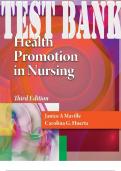Exam (elaborations)
FULL TEST BANK For Pharmacology: A Patient- Centered Nursing Process Approach, 9th Edition By Mccuistion Questions And Answers Graded A+
FULL TEST BANK For Pharmacology: A Patient- Centered Nursing Process Approach, 9th Edition By Mccuistion Questions And Answers Graded A+
[Show more]












